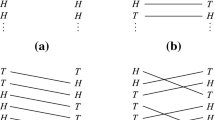Abstract
Anomalous events often lie at the roots of discoveries in science and of actions in other domains. Familiar examples are the discovery of pulsars, the identification of the initial signs of an epidemic, and the detection of faults and fraud. In general, they are events which are seen as so unexpected or improbable that one is led to suspect there must be some underlying cause. However, to determine whether such events are genuinely improbable, one needs to evaluate their probability under normal conditions. It is all too easy to underestimate such probabilities. Using the device of a number of ‘laws’, this paper describes how apparent coincidences should be expected to happen by chance alone.
Access this chapter
Tax calculation will be finalised at checkout
Purchases are for personal use only
Preview
Unable to display preview. Download preview PDF.
Similar content being viewed by others
References
AYRES I. (2007): Supercrunchers. John Murray, London.
BALDI P., FASCONI P., and SMYTH P. (2003): Modeling the Internet and the Web. Wiley, Chichester.
BARNETT V. and LEWIS T. (1978): Outliers in Statistical Data. Wiley, Chichester.
BOREL É. (1962): Probabilities and life. Dover, New York.
DIACONIS, P. and MOSTELLER F. (1989): Methods for studying coincidences. Journal of the American Statistical Association 84(408), 853-861.
FEYNMAN R. (1998): The Meaning of It All: Thoughts of a Citizen-Scientist. McGraw-Hill, New York.
GIUDICI P. and FIGINI S. (2009): Applied Data Mining. Wiley, Chichester.
HAND D.J. (2009): Modern statistics: the myth and the magic. Journal of the Royal Statistical Society, Series A, 172, 287-306.
HAND D.J. and BOLTON R.J. (2004): Pattern discovery and detection: a unified statistical methodology. Journal of Applied Statistics, 31, 885-924.
HAND D.J., MANNILA H., and SMYTH P. (2001): Principles of data mining. MIT Press, Cambridge, Massachusetts.
Author information
Authors and Affiliations
Corresponding author
Editor information
Editors and Affiliations
Rights and permissions
Copyright information
© 2010 Springer-Verlag Berlin Heidelberg
About this paper
Cite this paper
Hand, D.J. (2010). The Laws of Coincidence. In: Lechevallier, Y., Saporta, G. (eds) Proceedings of COMPSTAT'2010. Physica-Verlag HD. https://doi.org/10.1007/978-3-7908-2604-3_3
Download citation
DOI: https://doi.org/10.1007/978-3-7908-2604-3_3
Published:
Publisher Name: Physica-Verlag HD
Print ISBN: 978-3-7908-2603-6
Online ISBN: 978-3-7908-2604-3
eBook Packages: Mathematics and StatisticsMathematics and Statistics (R0)




